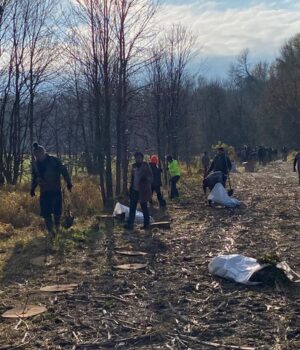Article submitted by the Muskrat Watershed Council
Despite the pandemic, the Muskrat Watershed Council (MWC) has continued working hard to improve water quality in Muskrat Lake and its watershed.
Their most recent project began in April 2021 and it was a big one. This large project was funded by a grant from the Ontario government’s Great Lakes Local Action Fund (GLLAF) and a micro grant from Watersheds Canada, Love Your Lake and the Canadian Wildlife Federation.
First, 1,928 metres of fencing was installed along waterways at two farms to keep cattle and sheep out of streams.
Then MWC and volunteers planted 5,600 trees and shrubs on 3,132 square metres of land on three farms.
They also put in two different types of watering systems for the livestock, who will no longer be drinking from streams. One system, which is seasonal and portable and uses a solar-powered battery, was paid for through the grant. The other system is year-round and uses a heated bowl supplied by the participating farmer.
After completing the planting, fencing and water system installation, the MWC collected and analyzed 25 soil samples from five fields on each of five farms. The whole project wrapped up with a soil workshop at the end of January 2022, when a soil expert helped farmers to interpret the sampling results and made practical recommendations.
Many volunteers from Opeongo High School, Jp2g Consultants, participating farmers and the wider community worked on the project along with MWC members. A total of 290 volunteer hours went into planning, fencing and planting.
Huckabone’s Equipment in Cobden provided personnel and filming equipment to make a video about the project. You can view it here:
YourTV Ottawa Valley also did a news piece about the project which you can view on the MWC Facebook page:
www.facebook.com/watershedmuskrat
There are many benefits to planting trees and shrubs and installing fencing along stream banks. It keeps animal waste out of the watercourse, which reduces nutrient buildup in the water that can add to algae blooms. It prevents shoreline erosion and damage to vegetation, reduces siltation, improves water oxidation and provides shade and habitat for fish, frogs and other wildlife. The newly-planted trees and shrubs also act as a filter to keep excess nutrients out of waterways.
It’s also much better for animals to stay out of streams. Besides keeping them from falling into the water and drowning, it also helps prevent injuries to their hooves and legs and keeps them from catching waterborne diseases like leptospirosis, which can cause them to abort.
Providing a source of clean drinking water brings even more benefits. It prevents livestock from accumulating high levels of algal toxins in their bodies and encourages them to drink more water to stay hydrated.
All in all, this project was a win-win-win. Farmers got healthier animals and fields that are not being gradually eroded along stream banks. Wildlife got a richer habitat. And cottagers and recreational users of Muskrat Lake got fewer nutrients flowing into their lake, which is the first step in reducing algae blooms.
To learn more about the work of the Muskrat Watershed Council, please visit this website:
muskratwatershedcouncil.com
To support the goal of a cleaner watershed for future generations, please consider donating to MWC and becoming a member. Memberships only cost $20 per person. As a registered charity, MWC will send you an income tax receipt.
The MWC is actively recruiting volunteers. If you would like to attend a meeting to find out more, please contact MWC at:
info@muskratwatershedcouncil.com
The Muskrat Watershed Council looks forward to seeing you soon!







![Kenopic/Smith Auction [Paid Ad]](https://whitewaternews.ca/wp-content/uploads/2018/10/advertising-100x75.jpeg)

